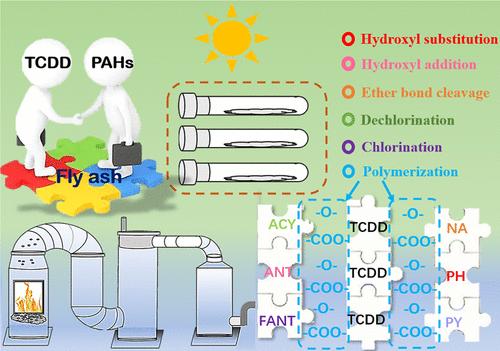当前位置:
X-MOL 学术
›
Environ. Sci. Technol.
›
论文详情
Our official English website, www.x-mol.net, welcomes your
feedback! (Note: you will need to create a separate account there.)
Cross-Coupling of 1,2,3,4-Tetrachlororodibenzo-p-dioxin with Six Coexisting Polycyclic Aromatic Hydrocarbons during Photodegradation on a Fly Ash Surface
Environmental Science & Technology ( IF 10.8 ) Pub Date : 2024-11-08 , DOI: 10.1021/acs.est.4c04681
Ying Zhang 1 , Shengnan Zhang 1 , Xiaoyu Li 1 , Zunyao Wang 1 , Ruijuan Qu 1
Environmental Science & Technology ( IF 10.8 ) Pub Date : 2024-11-08 , DOI: 10.1021/acs.est.4c04681
Ying Zhang 1 , Shengnan Zhang 1 , Xiaoyu Li 1 , Zunyao Wang 1 , Ruijuan Qu 1
Affiliation

|
The adverse conditions of the garbage incineration process can lead to the generation of dioxins and polycyclic aromatic hydrocarbons (PAHs). This study aimed to investigate the removal efficiency and possible cross-coupling effect of 1,2,3,4-tetrachlorodibenzo-p-dioxin (1,2,3,4-TCDD) and six coexisting low-molecular-weight PAHs during photodegradation on the fly ash surface. Due to their higher photoreactivity and light-shielding effect, the six PAHs exhibited inhibitory effects on the photodegradation of 1,2,3,4-TCDD, causing a reduction of 4.1%–21.2% in the removal efficiency. Common degradation products of 1,2,3,4-TCDD and PAHs were identified by LC–MS and GC–MS, and the formation of primary products was verified by theoretical calculations of bond dissociate energies, excitation energy, frontier electron densities, and transition states. In addition, high-molecular-weight coupling products of 1,2,3,4-TCDD and its interaction products with PAHs were observed in the mixed irradiation samples, and two coupling elimination mechanisms were proposed to illustrate their formation through C–O–C bonding and −COO– bonding, respectively. According to toxicity prediction analysis, the developmental toxicity and mutagenicity of most interaction products were higher than 1,2,3,4-TCDD. This study provided some new insights into the transformation, interaction, and related ecological risks of dioxins and PAHs coexisting on the surface of fly ash during the waste incineration process.
中文翻译:

1,2,3,4-四氯二苯并-对-二恶英与六种共存多环芳烃在粉煤灰表面光降解过程中的交叉偶联
垃圾焚烧过程的不利条件会导致二恶英和多环芳烃 (PAH) 的产生。本研究旨在探讨 1,2,3,4-四氯二苯并-对二恶英 (1,2,3,4-TCDD) 和六种共存的低分子量 PAHs 在飞灰表面光降解过程中的去除效率和可能的交叉偶联效应。由于其较高的光反应性和遮光效果,6 种 PAHs 对 1,2,3,4-TCDD 的光降解表现出抑制作用,导致去除效率降低 4.1%–21.2%。通过 LC-MS 和 GC-MS 鉴定了 1,2,3,4-TCDD 和 PAHs 的常见降解产物,并通过键解离能、激发能、前沿电子密度和过渡态的理论计算验证了初级产物的形成。此外,在混合辐照样品中观察到 1,2,3,4-TCDD 的高分子量偶联产物及其与 PAHs 的相互作用产物,并提出了两种偶联消除机制,分别通过 C-O-C 键和 -COO-键来说明它们的形成。根据毒性预测分析,大多数相互作用产物的发育毒性和致突变性高于 1,2,3,4-TCDD。本研究为垃圾焚烧过程中飞灰表面共存的二恶英和多环芳烃的转化、相互作用和相关生态风险提供了一些新的见解。
更新日期:2024-11-08
中文翻译:

1,2,3,4-四氯二苯并-对-二恶英与六种共存多环芳烃在粉煤灰表面光降解过程中的交叉偶联
垃圾焚烧过程的不利条件会导致二恶英和多环芳烃 (PAH) 的产生。本研究旨在探讨 1,2,3,4-四氯二苯并-对二恶英 (1,2,3,4-TCDD) 和六种共存的低分子量 PAHs 在飞灰表面光降解过程中的去除效率和可能的交叉偶联效应。由于其较高的光反应性和遮光效果,6 种 PAHs 对 1,2,3,4-TCDD 的光降解表现出抑制作用,导致去除效率降低 4.1%–21.2%。通过 LC-MS 和 GC-MS 鉴定了 1,2,3,4-TCDD 和 PAHs 的常见降解产物,并通过键解离能、激发能、前沿电子密度和过渡态的理论计算验证了初级产物的形成。此外,在混合辐照样品中观察到 1,2,3,4-TCDD 的高分子量偶联产物及其与 PAHs 的相互作用产物,并提出了两种偶联消除机制,分别通过 C-O-C 键和 -COO-键来说明它们的形成。根据毒性预测分析,大多数相互作用产物的发育毒性和致突变性高于 1,2,3,4-TCDD。本研究为垃圾焚烧过程中飞灰表面共存的二恶英和多环芳烃的转化、相互作用和相关生态风险提供了一些新的见解。





































 京公网安备 11010802027423号
京公网安备 11010802027423号